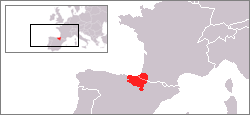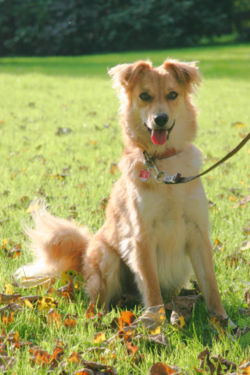
Basque breeds and cultivars
Encyclopedia

Basque people
The Basques as an ethnic group, primarily inhabit an area traditionally known as the Basque Country , a region that is located around the western end of the Pyrenees on the coast of the Bay of Biscay and straddles parts of north-central Spain and south-western France.The Basques are known in the...
in the Basque Country.
Some, such as the Alano Español
Alano Español
Alano Español, sometimes called the Spanish Bulldog in English, is a very large breed of dog of the molosser dog type, originating in Spain. The breed is best known for its former use during Spanish bullfights.- Appearance :...
, are not originally Basque but have only survived in the Basque Country.
Azpi Gorri
The Azpi Gorri is a breed of goat found in the GorbeiaGorbea
Gorbea or Gorbeia is a mountain and massif, the highest in Biscay and Alava , with a height of 1,481 m AMSL. The massif covers a wide area between the two provinces. The main mountain is a round grass-covered summit where a 20-metre-tall metallic cross has been constructed to reach the altitude of...
region between Álava and Biscay, the Encartaciones, Anboto
Anboto
Anboto is a limestone mountain of the Western Basque Country, the highest peak of the Urkiola range and not far from the pass of Urkiolamendi between Durango and Vitoria-Gasteiz.- Description :...
and Aramotz in Biscay. With less than 100 animals, it is considered an endangered rare breed.
Basco-béarnaise
The Basco-béarnaise (also encountered under the name Vasca Carranzana) is a sheep breed from the Northern Basque CountryNorthern Basque Country
The French Basque Country or Northern Basque Country situated within the western part of the French department of the Pyrénées-Atlantiques constitutes the north-eastern part of the Basque Country....
and Béarn
Béarn
Béarn is one of the traditional provinces of France, located in the Pyrenees mountains and in the plain at their feet, in southwest France. Along with the three Basque provinces of Soule, Lower Navarre, and Labourd, the principality of Bidache, as well as small parts of Gascony, it forms in the...
. Its characteristics are long, white wool, curved horns, weighing up to 80 kg. It is mainly a dairy sheep
Sheep milk
Sheep's milk is the milk of domestic sheep. Though not widely drunk in any modern culture, sheep's milk is commonly used to make cultured dairy products. Well-known cheeses made from sheep milk include the Feta of Greece, Roquefort of France, Manchego from Spain, the Pecorino Romano , the Pecorino...
and the milk (7.42% fat content, 5.39% protein
Protein
Proteins are biochemical compounds consisting of one or more polypeptides typically folded into a globular or fibrous form, facilitating a biological function. A polypeptide is a single linear polymer chain of amino acids bonded together by peptide bonds between the carboxyl and amino groups of...
s) is used to make the AOC
Appellation d'Origine Contrôlée
Appellation d’origine contrôlée , which translates as "controlled designation of origin", is the French certification granted to certain French geographical indications for wines, cheeses, butters, and other agricultural products, all under the auspices of the government bureau Institut National...
Ossau-Iraty
Ossau-Iraty
-Origin:Ossau-Iraty is produced in south-western France, in the Northern Basque Country and in Béarn. Its name reflects its geographical location, the Ossau Valley in Béarn and the Iraty Valley in the Northern Basque Country.-AOC status:...
cheese.
Basque Shepherd Dog

The Basque Shepherd Dog (pastor vasco in Spanish, artzain txakurra in Basque
Basque language
Basque is the ancestral language of the Basque people, who inhabit the Basque Country, a region spanning an area in northeastern Spain and southwestern France. It is spoken by 25.7% of Basques in all territories...
)is a dog breed
Dog breed
Dog breeds are groups of closely related and visibly similar domestic dogs, which are all of the subspecies Canis lupus familiaris, having characteristic traits that are selected and maintained by humans, bred from a known foundation stock....
common throughout the Basque Country.
Betizu

Encartaciones Donkey
The Encartaciones Donkey is the smallest Iberian donkey breed with males weighing between 170 kg to 210 kg and females 140–190 kg and not much talled than 120 cm.Latxa
The Latxa (ˈlatʃa), also encountered as lacha in the Spanish spelling is a Basque dairy sheep. They are mostly bred in BiscayBiscay
Biscay is a province of Spain and a historical territory of the Basque Country, heir of the ancient Lord of Biscay. Its capital city is Bilbao...
, Gipuzkoa and Navarre
Navarre
Navarre , officially the Chartered Community of Navarre is an autonomous community in northern Spain, bordering the Basque Country, La Rioja, and Aragon in Spain and Aquitaine in France...
for their milk which is used in the production of Idiazábal and Roncal
Roncal cheese
Roncal is a hard, creamy sheep milk cheese. It is made in one of seven villages in the Valle de Roncal of Spain. Roncal enjoys PDO status.-External links:*...
cheeses.
A medium to small sheep with a fairly coarse wool.
Pottoka
The Pottoka (poˈcoka) is an ancient but endangered breed of mountain horse. They are small horses with a large head, small ears, short neck, long back, shaggy mane and small hooves. Originally these roamed the Basque Pyrenees in a semi-feral state but today many are stabled.Basque Pig
The Basque Pig, also called Pie Noir du Pays basque, Euskal Xerria or Xuri eta beltza, is an indigenous breed of the Basque Country, standardized in France in 1921, and today endangered.Alubia pinta alavesa
The AlavanÁlava
Álava is a province of Spain and a historical territory of the Basque Country, heir of the ancient Lord of Álava. Its capital city is Vitoria-Gasteiz which is also the capital of the autonomous community...
pinto bean is a type of common bean
Common bean
Phaseolus vulgaris, the common bean, is an herbaceous annual plant domesticated independently in ancient Mesoamerica and the Andes, and now grown worldwide for its edible bean, popular both dry and as a green bean. The leaf is occasionally used as a leaf vegetable, and the straw is used for fodder...
.
Basque apple cultivars
Apple growing has a long history in the Basque Country, in particular for use in making Basque ciderSagardotegi
A sagardotegi is a type of cider house found in the Basque Country. Modern sagardotegis can broadly be described as a cross between a steakhouse and a cider house....
. The earliest written records on cider making and drinking go back to the 11th and 12th century, the very first being a record of Sancho III of Navarre
Sancho III of Navarre
Sancho III Garcés , called the Great , succeeded as a minor to the Kingdom of Navarre in 1004, and through conquest and political maneuvering increased his power, until at the time of his death in 1035 he controlled the majority of Christian Iberia, bearing the title of rex Hispaniarum...
sending an envoy
Envoy (title)
In diplomacy, an Envoy Extraordinary and Minister Plenipotentiary is, under the terms of the Congress of Vienna of 1815, a diplomat of the second class, ranking between an Ambassador and a Minister Resident....
to the Monastery of Leire
Monastery of Leyre
The Monastery of San Salvador of Leyre is a religious complex at the south of the Sierra of Leyre, in northern Navarre, Spain, standing out as one of the most important historical monasteries of Spain. The oldest records of the site date from 842, when Íñigo Arista, held as first king of Pamplona,...
in 1014 who mentions apples and cider-making. The other is the circa 1134 diary of the pilgrim Aymeric Picaud
Aymeric Picaud
Aymeric Picaud was a 12th century French scholar, monk and pilgrim from Parthenay-le-Vieux in Poitou. He is most widely known today as being the author of the Codex Calixtinus, an illuminated manuscript giving background information for pilgrims travelling the Way of St. James...
included in the Codex Calixtinus
Codex Calixtinus
The Codex Calixtinus is a 12th-century illuminated manuscript formerly attributed to Pope Callixtus II, though now believed to have been arranged by the French scholar Aymeric Picaud. The principal author is actually given as 'Scriptor I'....
who mentions the Basques being notable for growing apples and drinking cider. The 16th century inquisitor
Inquisitor
An inquisitor was an official in an Inquisition, an organisation or program intended to eliminate heresy and other things frowned on by the Roman Catholic Church...
Pierre de Lancre
Pierre de Lancre
Pierre de Rosteguy de Lancre or Pierre de l'Ancre, Lord of De Lancre , was the French judge of Bordeaux who conducted a massive witch-hunt in Labourd in 1609...
also refers to the Basque Country as "the land of the apple".
Many varieties exist and are used for making cider. Azkue
Resurrección María de Azkue
Resurrección María de Azkue was an influential Basque priest, musician, poet, writer, sailor and academic. He made several made several major contributions to the study of the Basque language and was the first head of the Euskaltzaindia, the Academy of the Basque Language...
's dictionary alone, which was printed in 1905, lists more than 80 Basque varieties of apples. Depending on the desired character of the finished cider, different varieties and proportions of apple varieties are used. Some common varieties include:
- Errezila, sharp and sweet (mottled green), the most common Basque apple variety
- Geza miña, sharp; also called sagar zuria and esnaola sagarra (green)
- Goikoetxea, sharp (red)
- Mokoa, sharp (red)
- Mozoloa sweet and fresh (green)
- Patzuloa, sweet and fresh (light green)
- Txalaka sour and sweet (bright green)
- Ugarte, sour (red)
- Urdin sagarra, sharp (apple red on top and green underneath)
- Urtebi txikia, sharp (yellow-green)
Espelette peppers
A variety of mild peppers with AOCAppellation d'Origine Contrôlée
Appellation d’origine contrôlée , which translates as "controlled designation of origin", is the French certification granted to certain French geographical indications for wines, cheeses, butters, and other agricultural products, all under the auspices of the government bureau Institut National...
certification, grown in the Northern Basque Country
Northern Basque Country
The French Basque Country or Northern Basque Country situated within the western part of the French department of the Pyrénées-Atlantiques constitutes the north-eastern part of the Basque Country....
in the Espelette
Espelette
Espelette is a commune in the Pyrénées-Atlantiques department in south-western France.It lies in the traditional Basque province of Labourd.-Sights:...
area.
Xapata cherries
Xapata (ʃaˈpata) cherries are a variety of black cherry with a very short fruiting season, lasting only a few weeks around June. They are cultivates mainly in the area around the Lapurdian town of ItxassouItxassou
Itxassou is a village in the traditional Basque province of Labourd, now a commune in the Pyrénées-Atlantiques department in south-western France.-External links:...
.
Pyrenean breeds
Several breeds of animals are common both in the Basque Country and other regions straddling the PyreneesPyrenees
The Pyrenees is a range of mountains in southwest Europe that forms a natural border between France and Spain...
.
Pirenaica
The Pirenaica is a breed of cattle found in the Basque Country, AragonAragon
Aragon is a modern autonomous community in Spain, coextensive with the medieval Kingdom of Aragon. Located in northeastern Spain, the Aragonese autonomous community comprises three provinces : Huesca, Zaragoza, and Teruel. Its capital is Zaragoza...
and Catalonia
Catalonia
Catalonia is an autonomous community in northeastern Spain, with the official status of a "nationality" of Spain. Catalonia comprises four provinces: Barcelona, Girona, Lleida, and Tarragona. Its capital and largest city is Barcelona. Catalonia covers an area of 32,114 km² and has an...
. There were more than 4000 Pirenaicas in the Basque Autonomous Community
Basque Country (autonomous community)
The Basque Country is an autonomous community of northern Spain. It includes the Basque provinces of Álava, Biscay and Gipuzkoa, also called Historical Territories....
in 1995 and the breed is not considered endangered.

